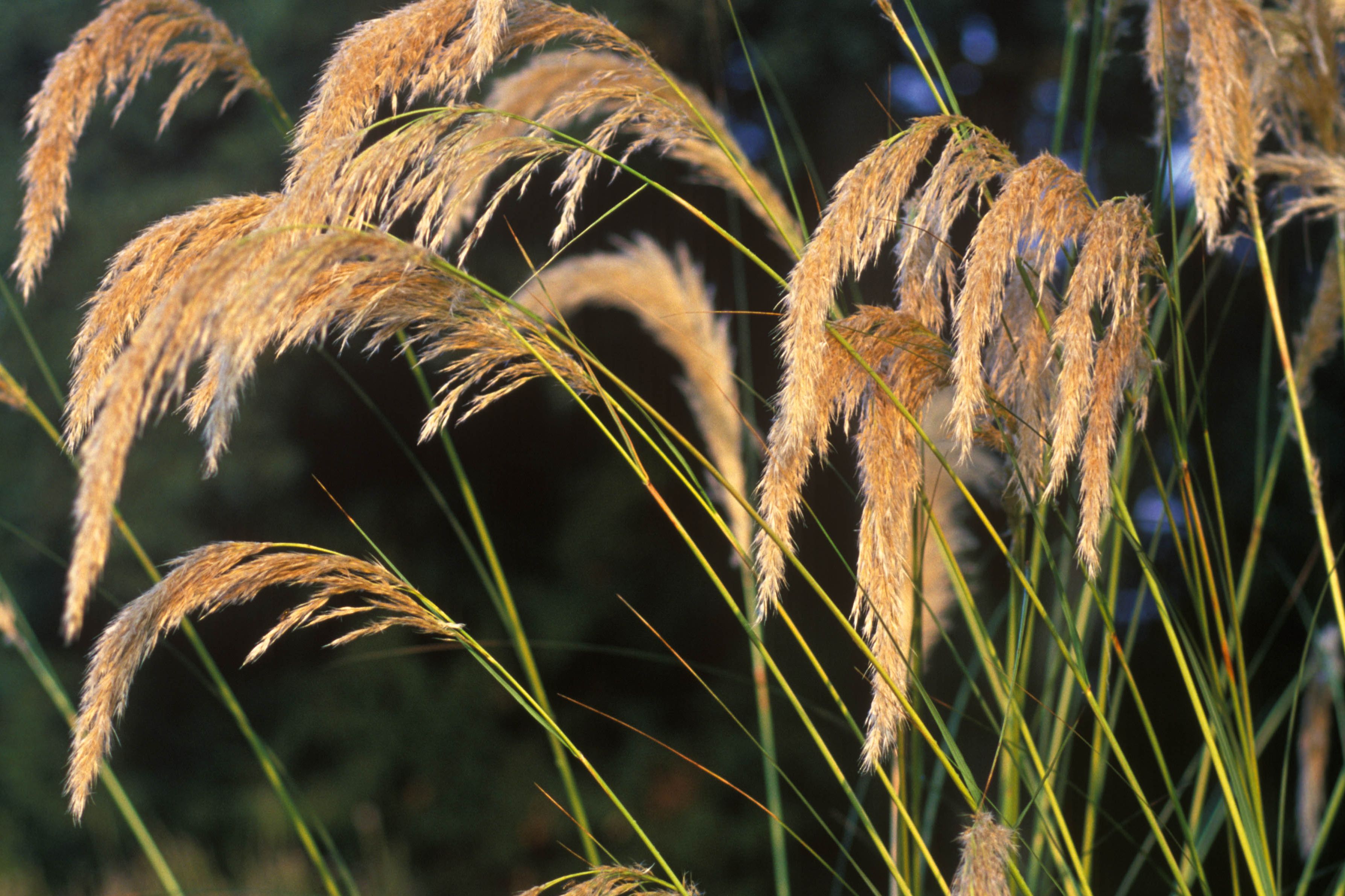Once hugely popular, pampas grass fell out of fashion, but along with growing numbers of dried flower enthusiasts, expert grower Adrian Bloom is keen to show they are worth a second look. He highlights the best that he grows in his own garden Foggy Bottom in Norfolk, and advises on growing them. Images by Adrian Bloom and Richard Bloom
Big, bold and beautiful might describe the range of ornamental grasses known as pampas grass. It was given the name pampas grass from the vast colonies in central Argentina, but it is also native to Chile, Peru, Bolivia, Paraguay, Uruguay and southern Brazil. Most now belong to the genus Cortaderia. Pampas grass was introduced into Britain in 1842. Given reasonable soil and good drainage in winter, Cortaderia selloana is hardy in most parts of Britain and is long-lived.
While few Cortaderia selloana fit comfortably in a small garden (though there are dwarf forms being developed) we should look afresh at how we can use pampas grass in modern gardens.
Every late summer and autumn, pampas grasses create a spectacular show of silvery plumes. Some have interesting variegated foliage and one cultivar has pink flower heads. There is also a cultivar that flowers earlier in the summer, in June.
Two similar species, originating from New Zealand, that are well worth considering have now moved from Cortaderia to Austroderia: Austroderia fulvida and Austroderia richardii. These were once considered on the borderline of hardy in the UK, but recent warmer UK winters mean they now seem reliable and offer a more graceful, arching appearance than the denser pampas grasses.
Read more on the reviving trend for pampas grass.
How to dry pampas grass
Dried pampas grass flower heads are becoming increasingly popular for interior decoration – they can also be used to make floral arches, Christmas wreaths and wedding bouquets. We asked Caroline Beck, cut flower grower and owner of Verde Flower Co, for her advice on drying grasses:
- In autumn, cut the grass stems to your desired length – use secateurs and be sure to wear gloves.
- Use garden twine or a rubber band to tie the stems together.
- Hang upside down in a dry, airy place for a few weeks – a greenhouse is ideal as this will bleach the stems.
Some people like to use hairspray to help prevent the plumes from shedding.
How to grow pampas grass
Where to plant pampas grass
Plant pampas grass in a sunny or semi shaded spot. Free draining soil, especially in winter, is essential. Make sure the area is clear of perennial weeds.
When to plant pampas grass
Planting can be done at most times of the year. Prepare the area, allowing space for a full display of what will become a large clump.
Cutting back pampas grass
Cut back old stems and a third of the foliage in spring. Catching the sharp-edged leaves with bare hands can give you a cut, so it is best to wear sturdy garden gloves.
Dividing pampas grass
Divide large clumps of pampas grass in late spring.
- Cut back foliage to 45cm.
- Dig around roots with a spade and lift the clump, removing most of the soil to make the plant easier to split.
- Lay the clump on its side and insert two garden forks into the centre of the clump back to back.
- Pull the fork handles outward and prise the clump apart.
If split clumps are still large, split again. Otherwise splitting can be done by hand, this time with two hand forks. Long roots can be cut and shortened by half. Plant slightly deeper than before as new roots will soon develop near the crown.
The best pampas grasses to grow
Cortaderia selloana ‘Pumila’

The most popular cultivar. It takes its name from the Latin for dwarf, although once established, this is a cultivar that can end up with spectacular white plumes that reach more than two metres in height. Cortaderia selloana ‘Pumila’ stands up to our winter winds, and the plumes, though less fluffy, are still attractive in April. Height and spread: 1.5m x 1.2m. AGM. RHS H6, USDA 8a-10b.
Cortaderia selloana ‘Aureolineata’

Sometimes sold as Cortaderia selloana ‘Gold Band’, this pampas grass has evergreen foliage that looks attractive in the garden most of the year and is striking in close-up. Height and spread: 1.8m x 1.2m. AGM. RHS H6, USDA 8a-10b.
Austroderia fulvida

A New Zealand grass that has moved from the Cortaderia genus to Austroderia. The arching, finely spaced flower heads reach over 2m and are nicely placed to having over lower plants. Summer flowering. Height and spread: 2m x 1m. RHS H5.
Cortaderia selloana ‘Sunningdale Silver’

Long spikes emerging in early autumn with large terminal inflorescences towering over 2m high. Hardy, but stems are easily broken without shelter from autumn winds. Shown here with Kniphofia tysonii and other perennials. Height x spread: 2.4-3m x 1.5m. RHS H6, USDA 8a-10b.
Cortaderia selloana ‘Pink Phantom’

Wispy inflorescences open as a striking pink, but fade to white. Arguably, the silvery white is a better match to the variegated foliage, which is broad and edged with white. Height and spread: 1.8m x 1.2m, perhaps taller in moister climates. RHS H6, USDA 8a-10b.
Cortaderia selloana ‘Patagonia’

For those who might find it useful to have an early flowering pampas grass – one that starts flowering in June rather than September. It was discovered by the American nurseryman Kurt Bluemel in the Argentinian province of Patagonia, and we have used it extensively for more than ten years in the Summer Garden at Bressingham, where its early performance has made an increasingly dramatic show. Height x spread: 1.5m x 1m. AGM. RHS H6, USDA 8a-10b.
Where to see and buy pampas grass
USEFUL INFORMATION
The Bressingham Gardens, Low Road, Diss, Norfolk IP22 2AA.Tel 07300 100445.
Web thebressinghamgardens.com
See website for details of opening times, and The Bressingham Gardens Nursery shop which offers some of the pampas grasses featured here.